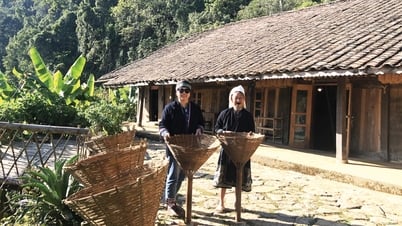A new study published in the journal Nature describes 13 fossilized teeth found at the Ledi-Geraru archaeological site in Ethiopia, belonging to both a primitive Homo individual and a previously unknown species of Australopithecus.
The study found that the fossils date back to 2.8-2.6 million years ago, adding to evidence that at least two ancient hominin lineages coexisted in the region at the time.
An international team of paleoanthropologists has discovered a new species of Australopithecus in Ethiopia, which lived at the same time as the earliest representatives of the genus Homo.
The discovery included 10 teeth belonging to a new Australopithecus species and three teeth belonging to a primitive Homo individual. However, due to the limited number of fossils, the new species has not yet been officially named.
The Ledi-Geraru site, located in Ethiopia’s Afar region and just a few dozen kilometers from Hadar — where the famous “Lucy” skeleton was found — has long been famous for important discoveries such as a 2.8 million-year-old jaw fragment, the oldest known human specimen, and ancient stone tools made by hominins around 2.6 million years old.
The research project here has been led by the University of Arizona since 2002. The discovery team, led by paleoecologist Kaye Reed from Arizona State University, is still excavating and searching for more fossils.
According to the researchers, the teeth of the Ledi-Geraru Australopithecus species are shaped differently than those of the known Australopithecus afarensis and Australopithecus garhi species.
Analysis of tooth enamel, size, and shape revealed differences large enough to distinguish from known species.
The team concluded that this was an entirely new species, not a variant of Australopithecus afarensis. However, they stressed that it was not possible to name a new species based on teeth alone, which would require more complete fossils, ideally a skull.
Fossil dating is done accurately by analyzing the volcanic deposits that cover the teeth. Volcanic ash contains feldspar crystals that allow scientists to determine the age of the deposits.
“We can date the eruptions when they were deposited here,” said geologist Christopher Campisano of Arizona State University.
Geologist Ramon Arrowsmith, also from the school, added: “The geology of the area provides very precise dating data, from about 2.3-2.95 million years ago.”
The team also reconstructed the ancient environment here, an ecosystem of tree-lined rivers, marshes and grasslands that were home to large herbivores.
The tooth enamel of these animals reflects a diet based primarily on grass. They describe a landscape where rivers flowed through vegetation and into shallow lakes, a stark contrast to the arid and fractured terrain of Ledi-Geraru today.
About 2.5 million years ago, three hominin genera, Australopithecus, Paranthropus, and Homo, coexisted, with many lineages overlapping in time and space.
“The picture that many people have of a linear evolution from ape to Neanderthal to modern man is completely wrong,” Reed stressed. “Human evolution is not that simple; it is random, like a dense tree with many branches, where organisms either adapt or go extinct.”
Diet is a key factor. Reed's team is analyzing tooth enamel to find out what the species ate. They hope to determine its diet based on wear marks on its teeth.
“If both species eat the same food in an arid environment, one species may be forced to switch to secondary foods or compete for survival,” Reed says, though she cautions that this hypothesis is speculative.
Many outside experts believe that this discovery has a great impact on the understanding of the geography and ecology of early hominins./.
Source: https://www.vietnamplus.vn/nghien-cuu-moi-he-lo-mot-loai-nguoi-co-chua-tung-duoc-biet-den-tai-ethiopia-post1056001.vnp






















![[Photo] Prime Minister Pham Minh Chinh talks on the phone with Cambodian Prime Minister Hun Manet](https://vphoto.vietnam.vn/thumb/1200x675/vietnam/resource/IMAGE/2025/8/15/72d3838db8154bafabdadc0a5165677f)
![[Photo] Firmly marching under the military flag: Ready for the big festival](https://vphoto.vietnam.vn/thumb/1200x675/vietnam/resource/IMAGE/2025/8/15/86df2fb3199343e0b16b178d53f841ec)

![[Photo] The special solidarity relationship between Vietnam and Cuba](https://vphoto.vietnam.vn/thumb/1200x675/vietnam/resource/IMAGE/2025/8/15/5f06c789ab1647c384ccb78b222ad18e)


![[Photo] Prime Minister Pham Minh Chinh attends a special art program called "Hanoi - From the historic autumn of 1945"](https://vphoto.vietnam.vn/thumb/1200x675/vietnam/resource/IMAGE/2025/8/15/c1c42655275c40d1be461fee0fd132f3)


![[Photo] Binh Khanh Bridge Ho Chi Minh City is ready to reach the finish line](https://vphoto.vietnam.vn/thumb/1200x675/vietnam/resource/IMAGE/2025/8/14/b0dcfb8ba9374bd9bc29f26e6814cee2)































![[Photo] President Luong Cuong receives Finnish Ambassador to Vietnam Keijo Norvanto](https://vphoto.vietnam.vn/thumb/402x226/vietnam/resource/IMAGE/2025/8/15/9787f940853c45d39e9d26b6d6827710)




































Comment (0)